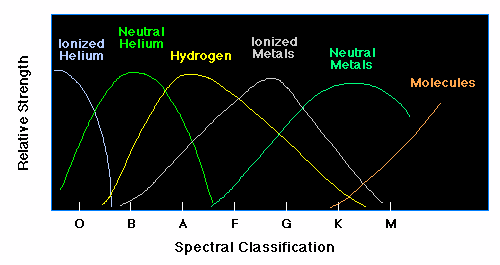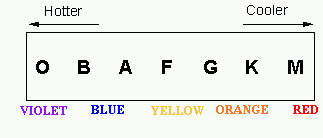Spectra of Stars (cont.)
The Hydrogen lines are weaker in B stars because they are getting too hot for
Hydrogen to exist in the right electronic state to create the Balmer lines.
For cooler stars, F, then G, the stellar photosphere is too cool to create
strong Balmer lines. Certain kinds of elements like (are strong in
absorption) certain stellar temperature ranges. Recall, we already had a
method to estimate temperature of a star by studying the 'color' of its light
and applying Wein's Law. The identification of atomic and molecular lines
in the star is an even more powerful estimate for stellar temperature.
 Helium holds on to its
electrons the strongest. Neutral metals, and even more so, molecules are easily ionized.
O stars exhibit ionized Helium lines because they are VERY HOT. M stars, which
have molecules in their atmosphere, are VERY COLD. O, B, A, F, G, K, M, is
a TEMPERATURE sequence. A common mnemonic to remember the sequence that has stuck since the
middle of the last century is: Oh Be A Fine Guy(Girl), Kiss Me!
Helium holds on to its
electrons the strongest. Neutral metals, and even more so, molecules are easily ionized.
O stars exhibit ionized Helium lines because they are VERY HOT. M stars, which
have molecules in their atmosphere, are VERY COLD. O, B, A, F, G, K, M, is
a TEMPERATURE sequence. A common mnemonic to remember the sequence that has stuck since the
middle of the last century is: Oh Be A Fine Guy(Girl), Kiss Me!
 100 years ago, We knew nothing of how the Sun or stars worked. Research at
that time merely plotted stellar properties against each other, looking for
possible patterns. What properties of stars were known at that time?
100 years ago, We knew nothing of how the Sun or stars worked. Research at
that time merely plotted stellar properties against each other, looking for
possible patterns. What properties of stars were known at that time?
- Spectral Classification.
- Relative Brightness.
But-- if they knew distance (via parallax), they knew LUMINOSITY.
For most stars, spectral types
(essentially temperature) and LUMINOSITY (=Absolute Magnitude),
were found to be related in a very unique way, giving us the Hertzsprung-Russell Diagram
